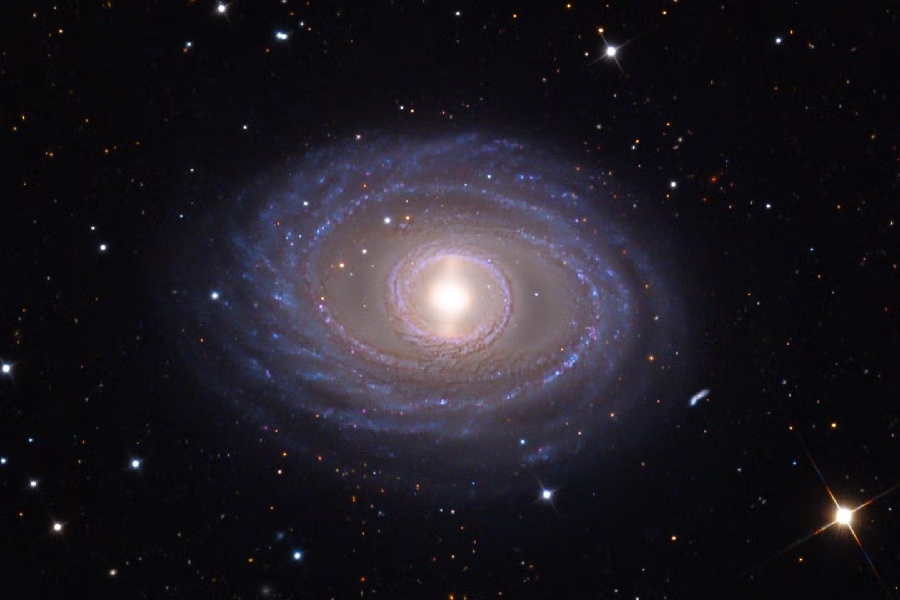Among the multitudes of galaxies that populate our universe, barred spiral galaxies stand out as stunning examples of galactic structure and complexity. But what is a barred spiral galaxy exactly?
In this article, we will unpack the intriguing dynamics of these barred behemoths. We aim to understand how their bars form, evolve and influence overall galactic structure. We’ll explore resonant orbital patterns induced by the central bar.
We’ll also see how supermassive black holes reside at the hearts of barred galaxies. These black holes interact with and alter the stellar bars through complex feedback loops. Get ready to unlock the secrets of barred spiral galaxies – their formation, evolution, and the intricate dynamics that set them apart.

What Is a Barred Spiral Galaxy?
What Is a barred spiral galaxy? A barred spiral galaxy features a central bar-shaped structure of stars, gas, and dust extending from its core.
This bar is surrounded by spiral arms containing regions of active star formation. Barred spirals, such as the Milky Way and NGC 1300, are common barred spiral galaxy examples.
These barred spirals are thought to be transitional galaxies, representing an intermediate stage between elliptical and spiral galaxies. The bar’s influence on a galaxy’s dynamics and evolution is significant.
Unique Features of Barred Spiral Galaxies
Barred spiral galaxies boast a unique feature – a central bar of stars and gas slicing through their bulge. Stretching for tens of thousands of light-years, these bars house billions of older stars that move in a fascinatingly rigid rotation.
The bar’s gravity acts like a cosmic conductor, orchestrating the flow of gas and stars. It creates resonant orbits, special pathways that guide gas in specific directions. Imagine celestial streams!
These streams funnel gas inwards, feeding the supermassive black hole at the galaxy’s heart, fueling its insatiable appetite. But the bar doesn’t just feed the beast; it also nourishes star formation. Gas gets pushed outwards along the bar’s ends, triggering bursts of new star creation – a dazzling display of stellar fireworks.
A gravity tug-of-war – Black holes versus bars
The relationship between the bar and the black hole is a complex dance. The bar fuels the black hole’s growth, but as the black hole becomes more massive, it exerts a stronger gravitational pull.
This tug-of-war creates a fascinating dynamic – the black hole’s increasing gravity eventually weakens the bar, limiting its growth and potentially leading to its eventual dissolution.
In essence, barred spiral galaxies showcase a unique interplay of gas flow, star formation, and a bar-black hole tug-of-war. These features set them apart, making them truly captivating objects in our vast universe.
Anatomy of Barred Spiral Galaxies
Barred spiral galaxies possess a distinct set of features that set them apart from their regular spiral brethren. Let’s dive into these key barred spiral galaxy characteristics.
At their core lies a central bar-shaped structure composed mainly of older stars. This hallmark feature, stretching for over 50,000 light-years, cuts across the galactic bulge and rotates rigidly as a unit.
The bar is made up of old stars in boxy orbits that give it its vertical extent. It also contains stars in elongated orbits that define its flat shape. Additionally, there are some young stars still forming in gas clouds along its edges.
The gravity of the bar drives characteristic gas flows by inducing resonant orbits aligned with the bar. These orbits channel gas into nuclear rings of intense star formation around the galactic center and into rings around the bar ends where they meet the spiral arms. This directly shapes spiral arm structure.
Thus, barred spirals have a predominately old central bulge and bar. They have rings of new stars around them and spiral arms flowing between gaps in these rings. Gas pours in and out along the bar at gaps where the rings meet the spiral arms.
The bar redistributes gas throughout the galaxy. This sparks new star formation in these rings long after initial bulge and bar stars have aged.
Formation and Evolution
The leading theory holds that barred spirals form through gravitational instabilities in galactic disks over time. As disks cool and become dynamically cold, they are prone to self-assembling bars. These bars arise from swing amplified density waves.
Disk stability depends on the disk mass fraction – higher ratios lead to instabilities that spur bar creation. Later-type disks that are cold but gas-poor readily grow bars. This occurs as stars get captured into rotational resonance orbits with the bar.
Once formed, bars drive internal galactic evolution by rearranging gas flows. They funnel gas to build central bulges and feed central black holes. Bars also transport gas to inner rings and the outer disk, sparking star formation. The accumulation of central mass can slow and dissolve bars over time.
Bars are transitory structures that form through disk instabilities. They dynamically reshape galaxies by promoting gas inflows and new star birth, long after a galaxy’s initial growth has ended. Interactions can also destroy or grow bars by altering disk stability.
Conclusion
As we have seen by exploring their distinctive anatomy, formation mechanisms, and role in galactic evolution, barred spiral galaxies are more than cosmic curiosities. They represent a dynamically complex and important phase in the life cycle of spiral galaxies.
So, what is a barred spiral galaxy more specifically? It’s a majestic spiral galaxy with a central bar-shaped structure composed of stars and gas. Driven by gravitational instabilities in aging galactic disks, these bars orchestrate intricate gas flows.
They are building bulges and fueling new star formation in rings and arms. Ultimately, they are shaping the evolution of many bright spiral galaxies across the universe.
We hope this exploration has helped bring barred spirals into sharper relief. It has shed light on the structure and dynamics of these rotating stellar linchpins. Gaining insight into barred spirals allows us to unlock more cosmic secrets. This moves us closer to a thorough understanding of our dynamic universe on both its grandest and most delicate scales.
